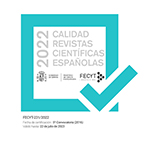Palynological analysis of unifloral commercial honeys
Abstract
Twenty eight honey samples labelled as monofloral and Spanish were studied by means of quantitative and qualitative methods: orange blossom (11), eucalyptus (10) and rosemary (7). Quantitative analysis displayed a higher number of botanical elements in eucalyptus honeys (354497/10 g of honey) than in orange blossom and rosemary honeys (100111 y 76705, respectively). Qualitative study showed high pollen richness in rosemary and orange blossom honyes (an average of 38 and 41 types of pollen, respectively), lower in the case of eucalyptus honeys (34). All of these types of pollen belonged to Iberian species, except in two samples (orange blossom and eucalyptus) with pollen grains from South America flora. Rosemary honeys reached 10% of Salvia verbenaca type, whereas one and two samples of orange blossom and eucalyptus did not exceed 10% and 70% of Citrus sinensis y Myrtus communis types, respectively.
Downloads
Article download
License
In order to support the global exchange of knowledge, the journal Botanica Complutensis is allowing unrestricted access to its content as from its publication in this electronic edition, and as such it is an open-access journal. The originals published in this journal are the property of the Complutense University of Madrid and any reproduction thereof in full or in part must cite the source. All content is distributed under a Creative Commons Attribution 4.0 use and distribution licence (CC BY 4.0). This circumstance must be expressly stated in these terms where necessary. You can view the summary and the complete legal text of the licence.







